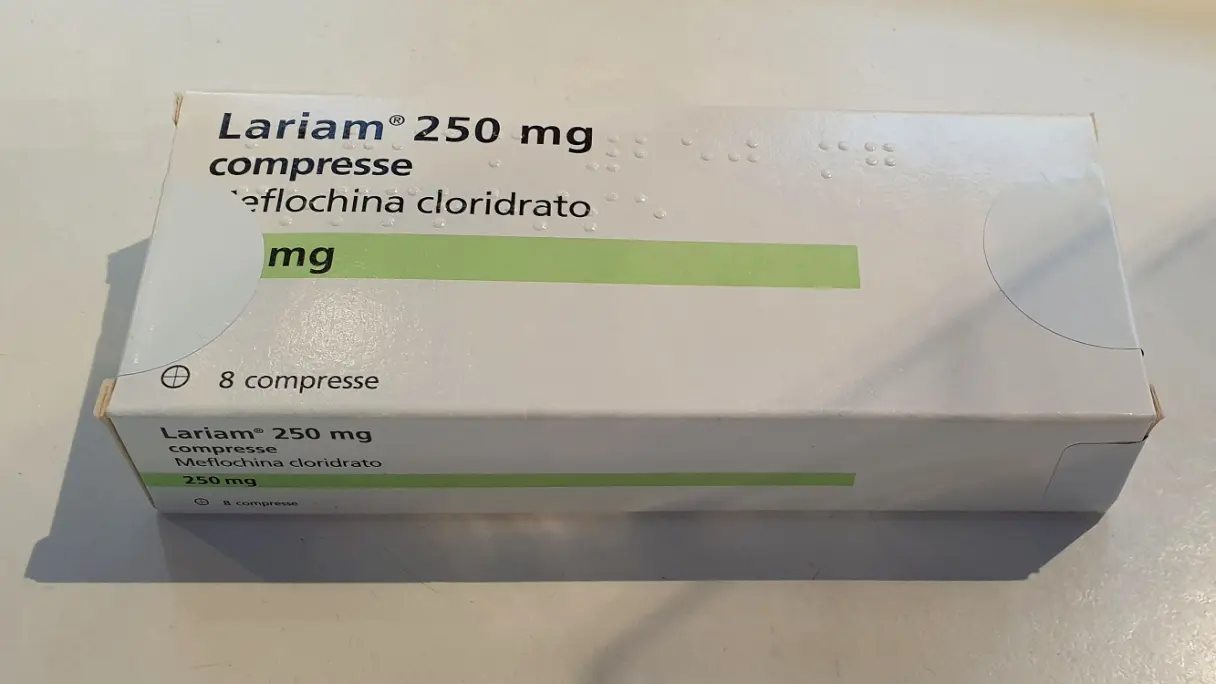Mefloquine #
| Common Nomenclature | Mefloquine |
| Street & Reference Names | Lariam; Mephaquin; Mefliam |
| Reference Dosage | 250mg [Patient.Info] |
| Anticipated: Onset / Duration | See below |
| Maximum Dose Experienced | 250mg |
| Form | Pill |
| RoA | Oral |
| Source / Jurisdiction | Prescribed / UK |
| Personal Rating On Shulgin Scale | ++ |

I searched long and hard, visiting over a dozen pharmacies, to find a box of lariam (to photograph). I eventually found this one in an international airport.
SUBJECTIVE EXPERIENCE #
There are a number of prescription drugs that can have deliriant, dissociative, or even hallucinogenic side effects. Often these manifest at doses well beyond those prescribed by medical practitioners, although not always. Generally I don’t consider these to be psychoactive drugs per se, but rather, drugs that can produce a (usually unwanted) psychoactive reaction in certain situations or for some people.
Mefloquine is a good case in point. It was first developed by the US military in the 1970s, and is used for both the prevention and treatment of malaria. However, its use can come with a whole range of unpleasant contraindications. Relating to the subject of this book, these can include the following:
“Psychiatric effects include nightmares, visual hallucinations, auditory hallucinations, anxiety, depression, unusual behaviour, and suicidal ideations.” ~ Wikipedia
The time to peak concentration of this drug is widely cited as 6-24 hours, with a half-life of two or three weeks. It does, therefore, appear to hang around in the system for quite a long time, albeit at a lower or reducing concentration.
I was prescribed lariam prior to a trip to The Gambia in the early 90s. I can’t recall my specific dose but I would assume that it was the generally prescribed 250mg tablet. This is taken weekly, starting one week prior to departure. I still recall my experience with it to this day. It was horrible.
In the background I felt a little weird; perhaps slightly distant or a bit off is a good description, although this was definitely low level, and in truth, barely noticeable. Unfortunately, this was only a prelude to the main event: lucid nightmares. These were really disturbing in nature and they went on and on, and not just on the first night (although this was the worst). The rest of my family, however, were totally unaffected. I have no idea why I was susceptible and they weren’t.
Bizarre and often disturbing dreams though are relatively common. Quoting from an article by the BBC, titled ‘My Lariam Dreams’ (https://www.bbc.co.uk/news/magazine-33957717):
“But soon every Thursday morning (we took the weekly pill on a Wednesday) was spent swapping stories about the hilarious, vivid, crazy - almost hallucinogenic - mefloquine-infused dreams we’d experienced the night before.”
Lest this should imply there is anything fun about taking lariam, I will refer to its Wikipedia page again:
“Serious side effects include potentially long-term mental health problems such as depression, hallucinations, and anxiety and neurological side effects such as poor balance, seizures, and ringing in the ears.”
This is really not where you want to be, at all, so I would very strongly suggest that this isn’t recreational and should only be taken if medically prescribed (and exactly as medically prescribed). There can be psychoactive-like effects, there is a touch of dissociation for some, but if a ride materialises it is frequently awful and the cost can be extremely high (and has even been causally associated with fatalities). I would now steer well clear of it, even if that meant changing my travel plans.
NOTE: Finally, why have I classified this drug as a dissociative, when it clearly isn’t one? It is here largely because it doesn’t fit well elsewhere either, and dissociative psychosis is often cited as a potential side effect.